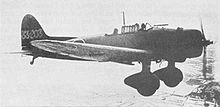Aichi D3A
| Aichi D3A | |
|---|---|
 Aichi D3A1 from the aircraft carrier Akagi |
|
| Type: | Dive bombers |
| Design country: | |
| Manufacturer: | |
| First flight: |
August 1936 |
| Commissioning: |
1940 |
| Production time: |
January 1938 to 1944 |
| Number of pieces: |
1,294 |
The Aichi D3A ( Jap. 九九式艦上爆撃機 , kyūkyū-shiki kanjo bakugekiki , dt "Type 99 of supported bomber". Allied Code Name : Val ) was a by aircraft carriers from inserted Sturzkampfflugzeug the Japanese manufacturer Aichi .
history
The development of the Aichi D3A began in early 1936 on the basis of studies of the German Heinkel samples Heinkel He 66 , Heinkel He 70 and Heinkel He 77 . It was designed as a single - engine low- wing aircraft with a fixed landing gear and was Japan's first dive fighter aircraft in all-metal construction and monoplane design . The Aichi D3A then received the designation of the Imperial Japanese Navy (fully literally translated) " 99 types of aircraft carriers used bombers ". The first flight took place in August 1936. This first machine was still powered by a nine-cylinder radial engine of the Nakajima-Hikari-1 type with an output of 710 hp (523 kW).
Production of the D3A1 began in January 1938 . In this case, it was powered by a 14-cylinder Mitsubishi Kinsei-44 double radial engine with 1,075 hp (791 kW) . Of this first series, a total of 470 aircraft had been produced by 1942. Then the successor D3A2 was created , which had improved aerodynamics and a Mitsubishi Kinsei 54 engine with 1,300 PS (970 kW) and of which 1,016 units were built by 1944.
In the hands of an experienced pilot , this aircraft was extraordinarily powerful and manoeuvrable. After dropping its bomb load - until the middle phase of the Pacific War - it was able to take up and survive an aerial combat with a fighter plane .
The pattern was instrumental in the attacks on Pearl Harbor on December 7, 1941 and was used throughout the war.
use
In the last phase of the war, the Aichi D3A was replaced in its traditional role by more modern machines and subsequently also used for kamikaze missions.
The Yokosuka D4Y Suisei ("Comet" - Allied code name : Judy ), which was flown for the first time in December 1940 and was also used until the end of the war, was developed as a more modern successor .
Technical specifications
| Parameter | Data (Aichi D3A2) |
|---|---|
| crew | a pilot and a navigator / gunner |
| length | 10.25 m |
| span | 14.37 m |
| height | 3.33 m |
| Wing area | 34.90 m² |
| Wing extension | 5.9 |
| Climb performance | 8.30 m / s |
| payload | 370 kg |
| Empty mass | 2,620 kg |
| Max. Takeoff mass | 3,800 kg |
| Wing loading | 84.20 kg / m² |
| Marching speed | k. A. |
| Top speed | 426 km / h at an altitude of 5,650 m |
| Service ceiling | 10,900 m |
| Range | 1,550 km |
| Max. Flight duration | k. A. |
| Engines | a 14-cylinder double radial engine Mitsubishi Kinsei 54 with 1,300 hp (956 kW ) |
| Armament | two 7.7 mm type 97 machine guns rigidly forward, one movable 7.7 mm type 99 machine gun in the observer position, a 250 kg bomb under the fuselage and two 60 kg bombs under the wings |
gallery
Replica of an Aichi D3A based on a North American T-6 Texan from 1986
Replica of an Aichi D3A based on a Vultee BT-13 Valiant (N56867) from 1968
See also
Web links
- Article with pictures about the Aichi D3A by Joao Paulo Julião Matsuura (English)
- Aichi D3A (Val) on aviation-history.com (English)





